2. GHANA
New Minister for Lands and Natural
Resources
His Excellency, John Dramani Mahama, the President of
Ghana has nominated a new Minster for Lands and
Natural Resources, Mr. Nii Osah Mills, a former president
of the Ghana Bar Association.
Mr.Osah Mills replaces Alhaji Inusah Fuesini, who
currently occupies the position. Mr. Emmanuel Okletey
Terlarbi has also been moved from the Ministry of
Defence to the Ministry of Lands and Natural Resources
as a Deputy Minister.
FLEGT Action plan agreed
Ghana and the European Union (EU) have signed a
memorandum of understanding (MoU) for the
implementation of the FLEGT Action Plan.
Addressing the media after the signing the Deputy
Minister of Lands and Natural Resources, Ms Barbara
Serwaa Asamoah, said on conclusion of the VPA trade in
illegal timber will be impossible.
The Head of the EU Delegation, Mr. Claude Maerten, said
¡°Ghana has demonstrated global leadership not only in the
application of the wood tracking technology but also in the
field of forest governance.
Private sector to be drawn into plantation
developments
The Forestry Commission (FC) is embarking on a forest
plantation development plan to meet the rapidly growing
demand for wood products and this will involve the
private sector in conservation and development of forest
resources.
At a National Colloquium on Forest and Wildlife resource
management in Accra, Musah Abu-Juam, Technical
Director in charge of Forestry at the Ministry of Lands and
Natural Resources, said the government has reviewed the
policy on Forests and Wildlife to ensure conservation and
sustainable development of resources in the sector.
The FC policy is to promote the rehabilitation and
restoration of degraded landscapes through forest
plantation development and enrichment planting.
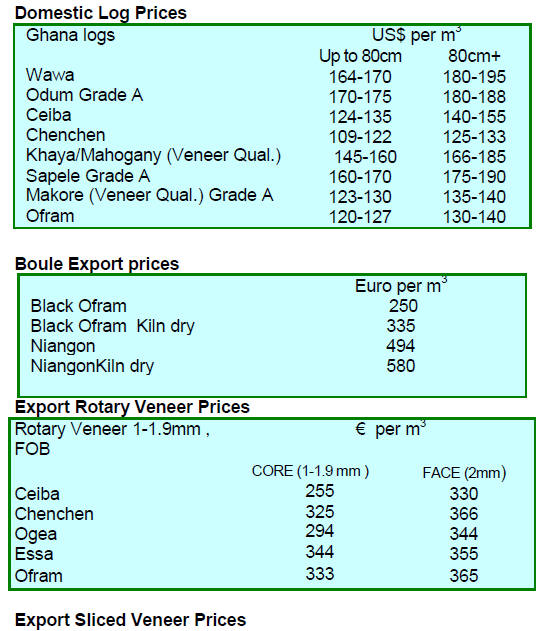
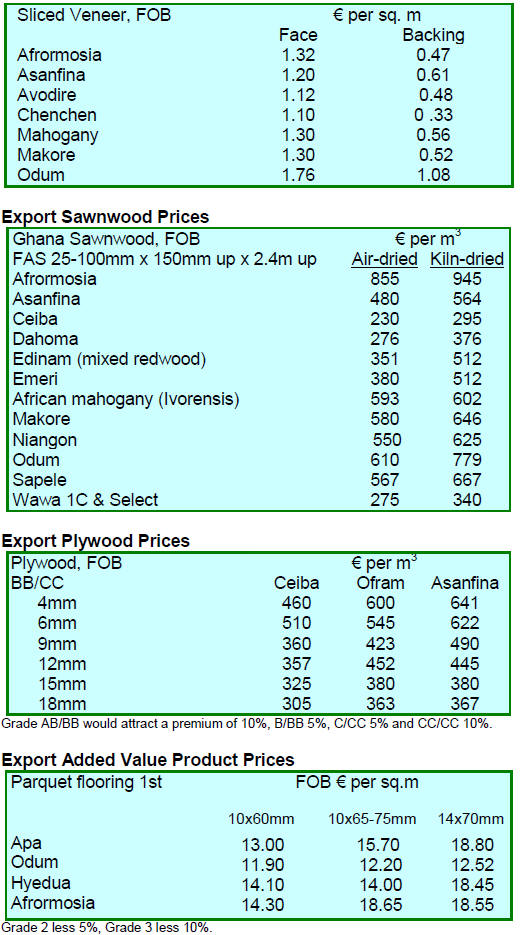
¡¡
3. MALAYSIA
17 million cubic metres of palm logs
available annually
Intensive research has been undertaken to assess how the
palm oil industry can supply more raw material for the
timber-based industry in Malaysia.
Data from the Malaysian Palm Oil Board for 2013 show
that 5.23 million hectares were planted with oil palm. The
total crude palm oil production was 19.22 million tonnes,
second only to Indonesia, the number one producer.
The industry is a major export earner and in 2013 exports
of palm oil and palm products earned RM61.36 billion
(approx. US$18.94 billion).
Productivity of the oil palm drops sharply when they are
25 ¨C 30 years old so the older stems are replaced. The
felling results in a huge amount of biomass part of which
is the palm stem and this has caught the attention of the
timber industry.
Every year oil palm replanting produces an
estimated 17
million cubic metres of palm trunks and this potential
additional raw material for the domestic industry.
There are many major challenges in further utilisation of
palm trunks, in particular they are vulnerable to insect and
fungi attacks so trunks have to be processed promptly.
In addition, and like cocowood, the palm trunk has varying
densities, heavier on the outside and lighter in the core,
heavier at the base and lighter at the top. Densities range
from 400-700 kg/cu.m on the outside to 150-250 kg/cu.m
in the core. This wide variation in densities poses a
problem in milling and utilisation.
A further challenge with palm trunks is that, again like
cocowood, they are difficult to saw and blunt saw blades
easily so stellite tipped saws must be used. In addition, the
moisture content across the diameter of a palm truck varies
widely making drying difficult.
R & D is ongoing to overcome the challenges in oil palm
trunk utilisation to turn the annual 17 million cubic metres
of palm logs into usable raw material.
Log exporters expect higher log sales to India
Timber companies in Sarawak have reported strong
exports of logs and plywood this year due to a spike in
demand for new houses in Japan. However, analysts
expect the increase in Japanese consumption tax from 5%
to 8% to impact demand for new homes in the short-term
which will mean stock levels of wood products in Japan
will be adjusted down.
Plywood traders in Sarawak have reported the following
export prices:
Floor base (FB) 11.5mm US$ 680 C&F,
Concrete formboard panels (CP) 3‟x 6‟ US$ 550 FOB,
Coated formboard panels (UCP) US$ 630 FOB;
Standard plywood:
Middle East (9-18 mm) US$ 480 FOB;
South Korea (8.5 ¨C 17.5 mm) US$ 490 ¨C 510 C&F;
Taiwan (8.5 ¨C 17.5mm) US$ 500 FOB;
China/Hong Kong US$ 480 ¨C 500 FOB.
India was the major buyer of logs from Sarawak in 2013.
Log exporters in Sarawak are closely watching to see if
the new government can deliver economic growth,
increased investment and control of inflation all of which
would improve prospects for increased exports from
Sarawak. Analysts are generally positive on prospects for
log exports to India this year.
4. INDONESIA
Second quarter should deliver faster
growth
The Bank Indonesia Deputy Governor Perry Warjiyo said
the Bank expects the economy to strengthen in the second
quarter and could achieve a 5.3 percent expansion.
Warjivo said second quarter growth will depend largely on
household consumption and investments which
traditionally peak in the second quarter.
Indonesian household consumption usually rises in the
second quarter because of higher spending during the
Islamic celebration of Ramadan and Idul Fitri. In recent
years household consumption has been accounting for
over 50 percent of economic growth in Indonesia.
April trade deficit weakens rupiah
A drop in exports in April resulted in a sharp drop in
Indonesia‟s trade balance becoming the second biggest
monthly deficit in five years. This disappointing export
performance hit the rupiah exchange rate and the rupiah
fell almost 1 percent to 11,785 to the US dollar.
The Bank Indonesia has stated it will continue with its
tight monetary policy in order to help stabilise the rupiah.
Furniture exports to EU set to rise
Prospects for increased sales of Indonesian furniture in
Europe are improving as the credibility of the Indonesian
Timber Legality Verification System (or Indonesian:
sistem verifikasi legalitas kayu SVLK) becomes widely
appreciated.
Exports of furniture are projected to grow by 50 percent
over the next year or two said Deputy Trade Minister,
Bayu Krisnamurthi.
Since the SVLK became mandatory Indonesia exports of
wooden doors has grown to between 13,000 to 15,000
doors per week said the minister.
Update on accreditation bodies
To-date, Indonesia‟s National Accreditation Body (KAN)
has accredited 14 Sustainable Forest Management
Verification Bodies (LPPHPL) and 11 Timber Legality
Verification Agencies (LVLK).
Accredited bodies are authorised to conduct assessments
and verification of forest management units and wood
processing plants following standards contained in the
annex to the Ministry of Forestry Regulation No. DG
BUK. P.6/VI-BPPHH/2012.
Sustainable Forest Management Verification Bodies are
accredited by KAN based on ISO / IEC 17021:2011 while
the Timber Legality Verification Agencies are accredited
based on based on ISO / IEC 17065:2012.
Sustainable Forest Management Verification Bodies
1. AYAMARU BAKTIPERTIWI, PT
2. SARBI INTERNATIONAL CERTIFICATION
3. SICS - SUCOFINDO, PT
4. ALMASENTRA CERTIFICATION
5. RENSA GLOBAL TRUST
6. MUTUAGUNG LESTARI, PT
7. PT. Forescitra Sejahtera (FOCUS QE)
8. NUSA BHAKTI MANDIRI, PT
9. EQUALITY INDONESIA, PT
10. MULTIMA KRIDA CIPTA (SUSPENDED)
11. PT. TUV Rheinland Indonesia
12. PT. Global Resource Sertifikasi
13. PT. TRANsTRA PERMADA
14. PT. Trustindo Primakarya
Timber Legality Verification Agencies
1. Badan revitalisasi Industri Kehutanan (BRIK)
2. PT. Sucofindo International Certification Services
3. PT Mutuagung Lestari
4. PT Mutu Hijau Indonesia
5. PT TUV Rheinland Indonesia
6. PT. Sarbi International Certification
7. PT SGS Indonesia
8. PT Equality Indonesia
9. PT. TRANsTRA PERMADA
10. PT. Trustindo Primakarya
11. PT. Ayamaru Certification
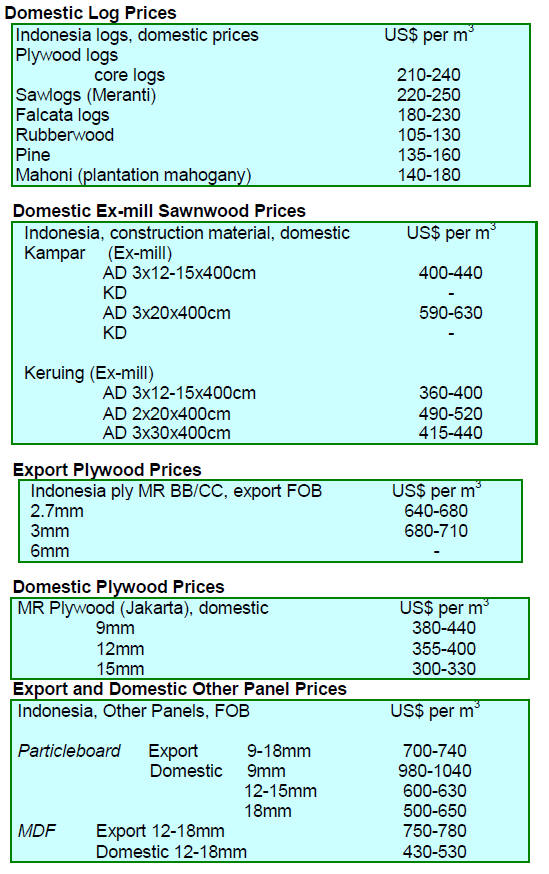
¡¡
5. MYANMAR
EU to provide support in preparation for
VPA
negotiations
The Myanmar press (Weekly Eleven of 2 June) has
reported a meeting between Isabel Faria de Almeida of the
EU Representative Office and MOECAF Union Minister
Win Tun held to open preliminary negotiations for a
Voluntary Partnership Agreement (VPA) with the EU.
Discussions centered on the provision of technical
assistance and training by the EU.
Analysts say that it is definitely in the interest of the
country to adopt a credible domestic system for timber
legality verification so exporters to the EU can satisfy the
due diligence requirements of EU importers.
They further commented that it would be advisable if
Myanmar first tackles legality verification before
certification, the route taken by most other ASEAN
countries.
Analysts warn that in other countries VPA negotiations
have been difficult as some conditions in the VPA
agreements are difficult to implement which could result
in exporters failing to secure a FLEGT license.
Given the experience in other countries analysts
recommend the conditions requested from the EU should
be studied in detail and possible implications carefully
assessed.
More on timber smuggling
According to reports from the Forest Department between
April 2013 and March 2014, 45,465 tons of illegal timber
and 14,732 tons of charcoal were seized by the authorities.
In addition 1,416 trucks, cranes and tractors , 157 tuolaji
(Chinese light tractors), 121 motor bikes, 267 motorised
boats and Z-craft (pontoons) and 378 sawmill machine
parts were among the item seized.
In related news, Myanmar Environmental Education Team
Chairman Sithu Lwin an eminent Forester and
Environmentalist, was reported to have commented that
despite whatever environmentalist say or hope for or
whatever is reported in the media, timber smuggling will
continue until there is rule of law in the country.
Another prominent local environmentalist, Ms. Devi Thant
Zin was quoted to have said that the penalties for timber
smuggling did not seem to be a significant deterrent.
Myanmar‟s forests are at risk because the Forest
Department is understaffed according to Zaw Win
Director General of the Forest Department.
Zaw Win said the department employed about 7,000
personnel but needed about 15,000 staff to properly
oversee the protection of Myanmar‟s remaining 320,000
square kilometres of forests.
Local forestry experts say the Forest Department is
doing
an unenviable task in trying to eradicate illegal activities.
Forest rangers are often faced with intimidation from
armed gangs in border areas and even in central parts of
the country, such as Bago and Sagaing regions.
The extent of illegal logging is such that it is difficult for
the Forest Department to combat this alone.
Myanma Timber Enterprise open tender prices
The next teak sales will be held at the end of June. The
following are prices reported for the sale on 26 May.
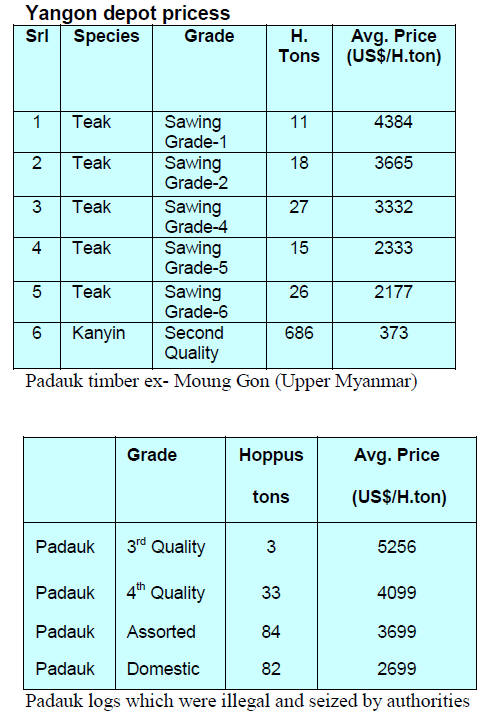
6.
INDIA
Streamlining regulatory processes
in forest and
environmental sectors
In India the Ministry of Environment and Forests will now
be known as Ministry of Environment, Forests and
Climate Change. This signals the importance the new
government attaches to environmental and climate change
issues and comes at a time when the country is determined
to contribute to global initiatives.
The ministry will also create a National Environment
Regulator to streamline regulatory procedures it will also
address the hundreds of projects which have been delayed
in the ministry for lack of official clearance.
In the past, environmental issues were being handled by a
number of authorities at the central and state levels and
each had a role to play in approvals, be it environmental,
forest, wild life, coastal or air and water pollution.
The new administration intends to streamline assessment
procedures and clearances for project in the industrial,
mining, infrastructure and environmental sectors.
Improving river transportation a new national priority
Extending river transport has become a national priority.
Plans are being developed to further expand opportunities
for waterway transport of passengers and goods.
An ambitious plan has been unveiled to develop the river
Ganges for such traffic and the media report a budget of
Rs.60 billion has been mentioned to improve the Benaras
to Calcutta route.
Redefine real estate sector to boost housing growth
With the new government already busy with plans for
economic revival there are high expectations in the
housing sector that infrastructure deficiencies in the
country will be addressed.
This is essential if the housing sector is to contribute to the
economy as the sector cannot grow without the foundation
provided by infrastructure.
India currently suffers from a crisis in urban housing and
can only break out of this if infrastructure, in its broadest
sense, is addressed. To spur urban housing growth there
needs to be investment in roads, water and electricity
supply, waste disposal, healthcare and education services,
communications.
The Indian real estate sector has long campaigned to be
recognised as an integral part of the infrastructure sector
not merely a business. If the government can deliver on
the infrastructure then the real estate sector will grow
rapidly.
The Confederation of Real Estate Developers Association
of India (CREDAI) Chairman Lalit Kumar Jain has
welcomed the move by the new government to grant
„infrastructure‟ status to the low-cost housing segment and
said the plans outlined by the government could, if
implemented, bring real change to real estate sector.
Real estate developers would prefer an infrastructure tag
to the whole housing sector but the government appears
likely to grant it only to the low-cost segment.
For more see: http://credai.org/sites/default/files/Issue-6-
Real-Estate-at-Glance-2-6-2014.pdf
Prices for imported plantation teak
The supply of plantation teak logs and sawnwood is
adequate to meet current demand and the strengthening of
the rupee from around Rs68 to Rs58 to the US dollar is
helping importers. Analysts expect the rupee to gain more
strength which will make teak imports cheaper.
Importers report that the average log size for plantation
teak from a few suppliers has been getting smaller and this
has affected prices being offered by Indian importers.
Current C & F prices for imported plantation teak, Indian
ports per cubic metre are shown below.
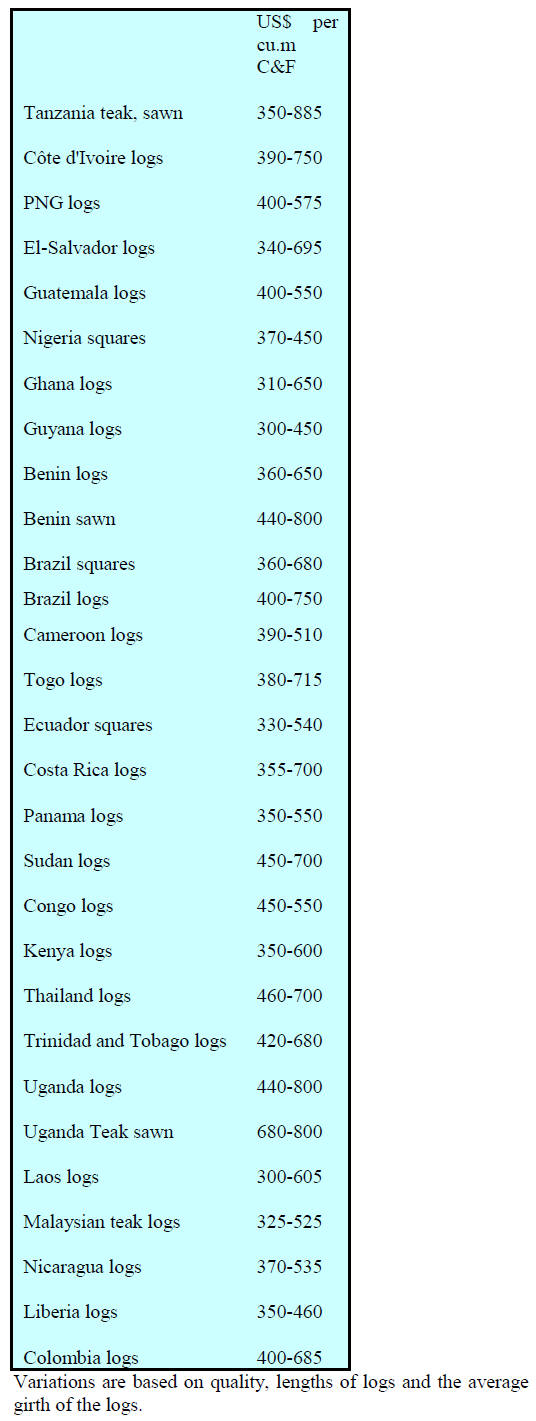
Domestic prices for sawnwood
Interest in non-teak tropical hardwoods remains firm as
many of these timbers are acceptable in the furniture and
joinery industries. Hardwood logs have started arriving
from Latin America and more new sources are likely as
the industry in India adjusts to the ban of log exports by
Myanmar.
Prices for air dry sawnwood per cubic foot, ex-sawmill are
shown below.
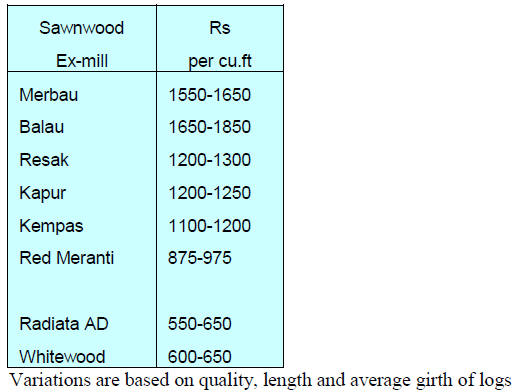
Myanmar teak processed in India
Teak decking export markets are very lucrative for Indian
manufacturers but other hardwoods such as cumaru and
ipe and substitute synthetic products are stealing market
share as many boat builders find they are available at a
fraction of the cost of natural forest teak decking.
However, there is a group of consumers who want only
Myanmar teak and they continue to support the trade.
Indian exporters and overseas importers are closely
watching developments in Myanmar to try and anticipate
prospects for future supplies of top quality teak.
Export demand for teak products processed in India is
steady and millers still have reasonable stocks according
to analysts. However, teak prices will continue to climb as
log stocks fall.
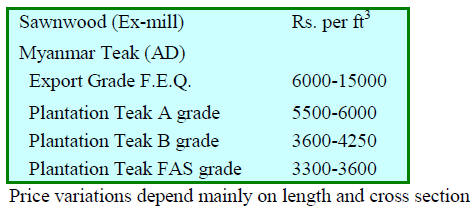
Imported sawnwood prices
Ex-warehouse prices for imported kiln dry (12% mc.)
sawnwood per cu.ft are shown below.
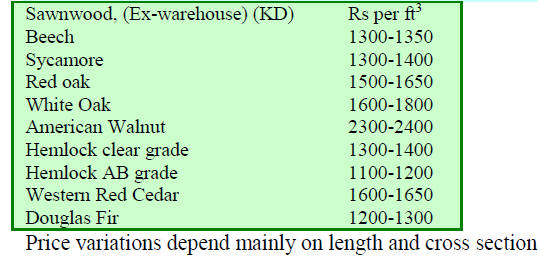
Century Plyboard posts good results ¨C bullish on
2014
prospects
Plywood maker Century Plyboard, the largest plywood
manufacturer in India, has a veneer manufacturing plant in
Myanmar which, say company officials, can support all
the requirements of the Indian factories which produce
plywood.
A spokesman from Century Plyboards said, ¡°the log
export ban in Myanmar has resulted in a sharp fall in log
prices in Myanmar, it has also resulted in a 15-20% rise in
the price of veneers produced from logs imported into
India before the ban delivering a double benefit to the
company¡±.
Plywood industry struggles with labour shortage
The latest estimates indicate that India has over 2,000
small and medium sized plywood mills across the country.
As the number of mills increases the problem of labour
shortages worsens and mills are forced to operate well
below capacity.
The stronger rupee is opening an opportunity for more
imports of both logs and plywood. Increased imports of
poplar and beech have been observed and the range of
species imported from S. America and Africa for plywood
manufacture is likely to grow.
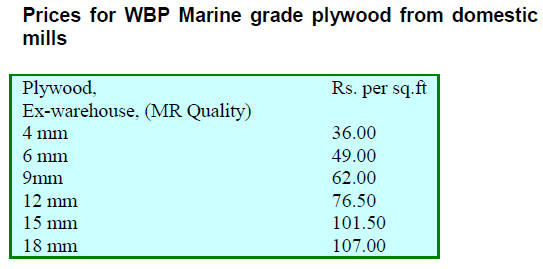
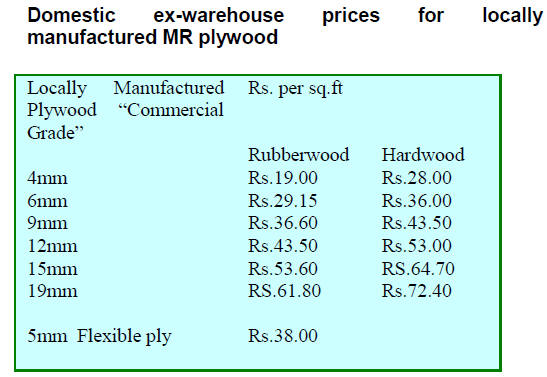
¡¡
7.
BRAZIL
"Arc of Deforestation‟ focus of national
forest
inventory
As of June this year the National Forest Inventory
(Invent¨¢rio Florestal Nacional - IFN) has been completed
in Santa Catarina and the Federal District and is underway
in the states of Cear¨¢, Rio Grande do Norte, Sergipe, Rio
de Janeiro, Esp¨ªrito Santo, Paran¨¢ and Rio Grande do Sul.
The Brazilian Forest Service (SFB) established
partnerships with state governments, universities and
research institutions to implement the inventory.
In the Amazon, the inventory is focussing first on forest
areas of greatest vulnerability known as the „Arc of
Deforestation‟ namely five areas in the states of Rondônia,
Southern Amazonas, Manaus, Northwestern Mato Grosso
and Southeastern Par¨¢.
ABIMCI and producers discuss expanding
international market share
The Brazilian Association of Mechanically Processed
Timber Industry (ABIMCI) recently met with pine,
tropical hardwood and laminated plywood manufacturers
from around the country that together produce about
116,000 cubic metres or 84 percent the Brazilian total
exports of these products.
The manufacturers wished to get advice on how to secure
a more prominent position in the international market and
the impact that high production costs are a serious
handicap.
ABIMCI presented data on a case study which showed
that in plywood production margins are very small
because inflation is constantly pushing up production costs
but prices in the international markets are stagnant.
Small producers get state support
Guarantã do Norte will be the first municipality in Mato
Grosso State (Amazon region) to have a Local Productive
Arrangement (APL) project to support small producers.
This initiative came from the Center for Wood Producers
and Exporters of Mato Grosso (CIPEM) and support was
forthcoming from the State Secretariat for Industry,
Commerce, Mines and Energy (SICME) and the Brazilian
Support Service for Micro and Small Enterprises
(SEBRAE).
According to SICME, the object is to tackle some of the
main problems in the forestry sector such as timber
pricing, level of taxes imposed by the State Secretary of
the Environment (SEMA) and the use of timber transport
documentation amongst others.
According to SEBRAE, the APLs will be successful if the
union of small producers can create networks that sustain
the local market. To this end entrepreneurs are being
encouraged to pay more attention to marketing, market
analysis and sector networking as well as collaboration
with institutions which can offer assistance.
Brazilian sawnwood exports
Brazilian tropical sawnwood exports from January to April
2014 fell 2.4% in value and 9.2% in volume, compared to
the same period last year.
The main export markets for Brazil‟s tropical sawnwood
in terms of value were France (14%), the United States
(13%), China (12%), Netherlands (10%) and India (9.5%).
In terms of volume, between January to April 2013
Brazilian tropical sawnwood exports totaled 110,670 cubic
metres while in 2014 the figure was was 101,335 cubic
metres. In terms of total value, 2013 exports were US$59
million while 2014 exports totaled US$58 million.
The main states providing sawnwood exports in 2014, in
terms of value, were Par¨¢, 40.6% of all tropical sawnwood
exports, followed by Mato Grosso (23%), Rondônia
(17.5%) and Paran¨¢ (9.9%).
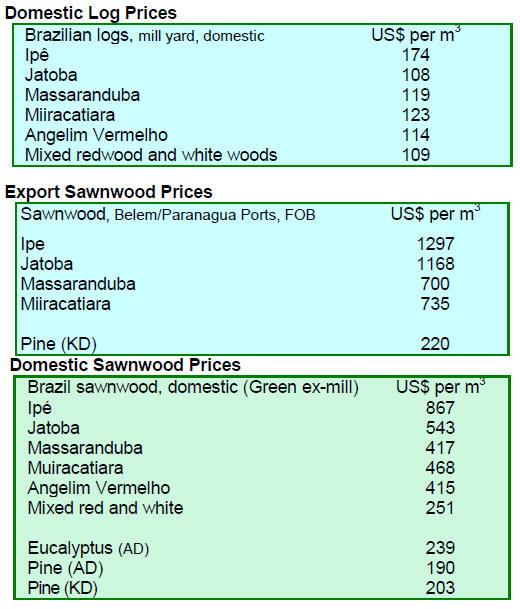
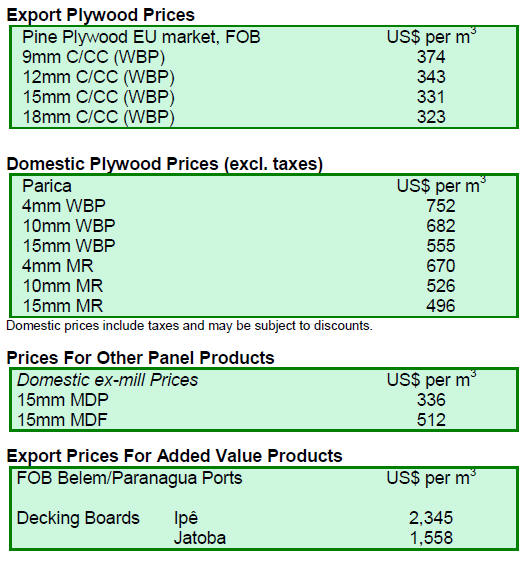
8. PERU
Huge investment in forest inventory
planned
The government plans to invest around US$ 6 million to
conduct an inventory of forest resources. To this end the
President has sent a bill to Congress that will authorise the
allocation of funds to the Ministry of Agriculture and
Irrigation (MINAGRI).
The money will be used to fund infrastructure
improvements, training, equipment modernisation and the
upgrading of technical administration within the
Directorate of Forestry and Wildlife (ATFFS).
The General Directorate of Forestry and Wildlife of the
MINAGRI has decentralised offices or ATFFS whose role
is the management and control of forest resources and
wildlife but many cannot function effectively. Currently,
13 ATFFS require additional resources and equipment,
particularly for operations at checkpoints.
FENAFOR scheduled for October
The fifth National Forest Fair (FENAFOR) will be held
from 23 to 25 October in the exhibition area of La Molina
National Agrarian University in Lima.
FENAFOR provides an opportunity for companies to
strengthen ties and promote business contacts as well as
providing investors to develop business contacts.
This fair will bring together producers of a wide range of
products and services in the forestry and wood processing
sectors.
FENAFOR is one of the leading trade fairs in Latin
America promoting new technologies, technical solutions
and industry trends. In the previous FENAFOR almost
half the exhibitors were from Germany, Argentina, Brazil,
Colombia, Chile, Spain, Italy and the USA.
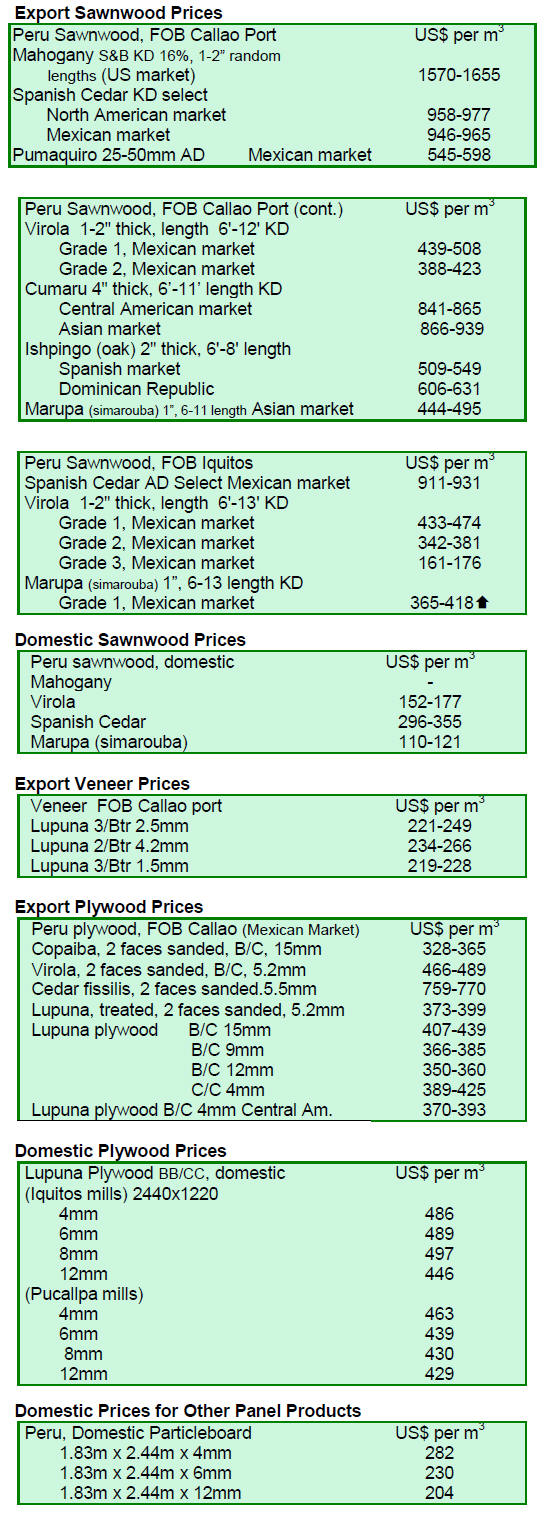
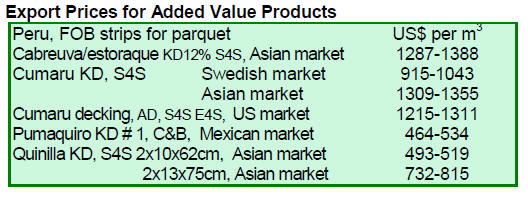
¡¡
9.
GUYANA
On-site RIL training for forest
communities
The Forestry Training Centre Incorporated (FTCI),
recently conducted on-site Reduced Impact Logging (RIL)
training for the Kaburi Amerindian Village community
and the Rockstone Loggers‟ Association.
The RIL based training comprised three training modules:
(a) „Introduction to Forest management for Communities‟
which exposed villagers to the tangible and intangible
benefits of forest resources, the legal framework for
forestry practice, and basic steps to take in managing
forest resources, whatever the objectives of management;
(b) Surveying, mapping and forest inventory which
provided trainees with most of the knowledge they need
for planning of timber harvests;
and (c) directional felling and chainsaw milling with a
board mill which aimed to help chainsaw operators
optimise all trees harvested.
For the training at Kaburi Amerindian Village, FTCI
collaborated with UNDP‟s Global Environment Facility
(GEF) Small Grants Programme to train sixteen persons.
Kaburi Amerindian Village has a population of 350 and a
forest area of 10,772 ha of mostly intact, communal forests
and they would like to carry out logging in a sustainable
manner.
For the training for the Rockstone Loggers Association,
FTCI collaborated with the Guyana Forestry Commission
(GFC) which is implementing an Institutional Support
Project within its REDD+ Secretariat that supports
Guyana‟s Low Carbon Development Strategy. The GFC
Rockstone Village has a population of about 300 and a
forest concession of about 4,088ha.
Both communities have asked FTCI to prepare forest
management plans that reflect a multiple use approach to
the management of their respective forest resources. FTCI
expects to see other forest based communities adopt the
models being developed at Kaburi and Rockstone.
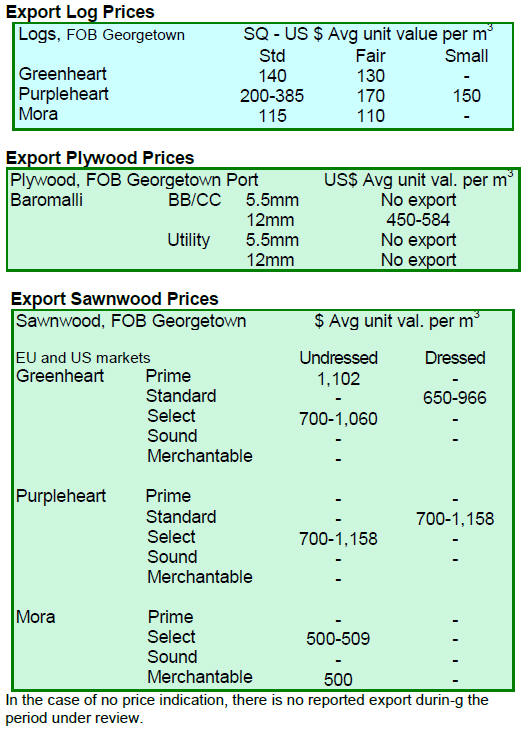
¡¡
